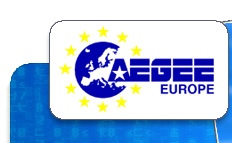Interactive games
Balloon Stomp
Duration: app. 10-15 minutesPreparation time: app 10 minutes
Equipment: ballons and statements
Cut up statements about Europe, roll them up and put them in separate ballons, which you blow up.
Everyone has to burst a balloon and try to find an answer to the question/ discussion.
Note: you can use the discussions from the material. You can also build groups through this activity
Map of Europe
Duration: 10 minutesPreparation: 10 minutes
Equipment: papers
Prepare different papers for each student. They get one card saying from which country they are (not the country they are originally from). Another card is the money they have (Euro, Zloty,... wherever they are from), maybe another one for the country they want to go to and another one for Visa.
Now simulate a journey: some can travel without any problems (e.g. Germany- Spain: no passport control, same currency), some need to change money (e.g Denmark - Greece), some need Visa (do they have it?), some need to change money (or have they already done?)
You can decide, what you want to show and if you let them travel to the country. You can show the difficulties for some of them, because they forgot their visa/passport/ do not have the right currency...
Let them build a map of Europe according to the places they are from in that game
Who am I?
Let students express how they feel: do they think more regional, national, European?
Possibilities how to express it:
- make a collage
- create a poster
- have a map where they can place little spots where they see themselves
- let them move around in the room and make clear where they are European/ national/ regional
Fish bowl
This means it good when it comes to discussions.
Have 4 chairs in the middle, the other in a circle around it. Three people always have to be in the middle, a fourth is optional, so one chair can be free.
At the beginning three people are in the beginning introducing into the topic and starting discussing it. If someone from the outer circle wants to say something, he can go and sit on the 4th chair. If another person wants to join now, he needs to tell someone else by tipping on his shoulder that he would like to take his seat. People from the inner circle can leave it if they want to and there are still 3 people in the inner circle.
Walt Disney Method
similar to fish bowl, but every person gets a fixed role:
- the dreamer is very subjective in answering questions and is very enthusiastic about it, but never prepared to make a decision or to analyse the idea thoroughly
- the realist pushes the development of the idea forward, controlling all necessary steps, conditions and qualifications
- the censor challenges the participants and examines the defaults. His aim is constructive and positive criticism to identify sources of errors
- the fourth person is the neutral advisor (could be the group leader)
Other simple methods to actively involve students
- Brain walking:
- alternative 1: each student gets a piece of paper and has to write down an idea/ sentence/ word to a specific topic, then come to the front and pin it on a wall/ the blackboard/...
- alternative 2: as the name says: go for a little walk with your students and let them discuss a topic
- getting the mood of a group: You can use the easy way of letting everyone raising their arms if they agree to an aspect. But you can also make it
more active:
- prepare a picture on the blackboard (maybe you have collected ideas through a brain walk) and let the students stick something on their preferred topic/ what they think is correct/ most important. They can also use a pen and simply make a sign on the paper
- make a vote with cards: red is against, green is in favour
- divide the room into several parts and tell which idea/answer is in which corner, then let the students go to their choice. If you want to continue with a group work, you might also have the different groups now

